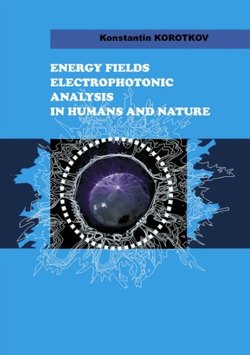Читать книгу Energy Fields Electrophotonic Analysis In Humans and Nature - Konstantin M.D. Korotkov - Страница 24
На сайте Литреса книга снята с продажи.
Where does the electronic current in the body come from?
ОглавлениеLet us look at the time curve of the EPI signal of the skin (fig. 1.1). A typical curve initially falls, and shortly after the beginning of the measurement it stays at a relatively stable level, with occasional fluctuations.
Fig.1.1. Time dependence of EPI signals from human finger.
There are two phases in this process. The initial stage is the extraction of electrons located in the outer layers of the cutaneous covering and the surrounding tissue. The number of these electrons is limited, which is why the current constantly decreases.
In the second phase, electrons from the deepest tissues in the body are included in the current flow. These electrons have several sources.
Some of these belong to molecular albuminous systems, and in accordance with the laws of quantum mechanics, these electrons are dispersed among all the molecules. It is as if they are ‘collectivized’ between groups of molecules, so in principle it is impossible to say where an electron is at a given time. They form a so called ‘electron cloud,’ occupying a specific area in space. We can see similar clouds in the blue July sky, and when a drop of rain falls on you, you can never tell from which part of the cloud the drop fell.
So the electron current in biological tissues is a transfer of electron-stimulated states along chains of albuminous molecules
Rubin, 1999
Other sources of electrons in EPI processes are free radicals which form in the blood and tissues. There is a widely-held view that free radicals are the worst enemy of health, and that they should be fought in every way possible. Yet the body converts 70% of inhaled oxygen into free radicals, to be able to use them straight away. Why is this process necessary? Over millions of years of evolution, could nature not have managed to change a mechanism harmful to health? Clearly, since the process of formation of free radicals was retained, it is necessary for biological functioning. Indeed, as has been demonstrated recently, free radicals are one of the sources of electrons and during free radical reactions; energy is transferred and converted [Voeikov et al., 2003]. Consequently, blood is one of the main substrata of the electron current.
If we look again at fig. 1.1, we can see that, in the second phase, with the establishment of a quasi-stable current, mechanisms for the transfer of electrons are engaged along the albuminous molecules mainly in the connective tissue, and along the circulatory system. In other words, the ‘electron storehouse’ of the body is engaged.
When the body is functioning normally, electron clouds are distributed among all systems and organs. Active transfer of oxygen to the blood takes place and all tissue consumes oxygen, using it in a cascade of biochemical conversions. Among the main consumers of these processes are the mitochondria, which use electrons to convert ATP energy molecules. In this case, the active transfer of electrons to the tissue is ensured, as is the free radical mechanism of transferring electrons to the blood, which is evident in the quasi-stable current during EPI stimulation.
In cases of imbalances and dysfunctions, immunodeficiency, or an abnormality of the micro capillary blood circulation, the transfer of electrons to the tissue is hindered. Free radical reactions do not flow in full volume, the ‘electron storehouse’ of the body is not full, and the stimulated current is either very small or is very irregular in time. Fig. 1.2 shows a dynamic curve for a patient with such abnormalities. As is clear when comparing Figures 1.1 and 1.2, the patient’s dynamic curve has much higher variability.
Fig.1.2. Time dependence of EPI signals from human finger.
Therefore, the lack of glow on the EPI-gram is an indicator of the impeded transfer of electron density to the body’s tissues, and an abnormality in the flow of free radical reactions. This is an indicator of an abnormality in the energy supply of organs and systems.
It now makes sense to come to grips with the concept of energy itself, and how this concept is linked to the body’s state.
